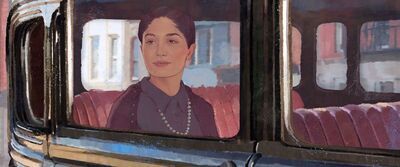Strays

Full disclosure, right off the top: I knew I was going to be a soft touch on “Strays.”
We’re a longtime Boston Terrier family, and I’ve always wondered what our dogs would sound like if they could talk to us. (Surely, I’m not the only one who entertains such insane ideas.) So the prospect of an R-rated comedy in which Jamie Foxx provides the voice of a street-smart Boston named Bug—who drops copious F-bombs, gets high on mushrooms, and humps discarded couches—was very exciting.
“Strays” is pretty much a one-joke movie, one last romp at the end of summer. But it finds enough ways into that joke within its perfectly pithy running time to remain zippy and enjoyable. The way it upends heartwarming dog adventure movie tropes is often hilariously inspired. And there’s great chemistry within the voice cast, particularly between Foxx and star Will Ferrell, who had the unusual benefit of recording together.
Director Josh Greenbaum has shown a flair for out-there comedy with a sweetness at its core in the delightfully bizarre “Barb and Star Go to Vista Del Mar” (2021). He achieves a similar balance with raunchier material in “Strays.” Besides featuring a ton of profanity, the screenplay from Dan Perrault includes plenty of poop and pee jokes (not all of which are entirely puerile), vigorous humping, and some wilderness mayhem that some may find shocking. But the film also explores the importance of identifying and escaping toxic relationships, achieving a sense of self-worth, and basking in the support of deep and unexpected friendships.
I may have teared up a few times. Like I said at the start, a soft touch. Your mileage may vary on this canine road trip.
“Strays” begins on an upbeat note with narration from Ferrell as Reggie, an adorably scruffy Border terrier who’s clueless to the fact that his miserable, abusive owner (Will Forte) hates him and keeps trying to abandon him. “Today is going to be the best day ever!” he intones in a sunny manner reminiscent of Margot Robbie’s optimism at the start of “Barbie.” And totally coincidentally, “Strays” shares a similar structure to Greta Gerwig’s mega-blockbuster: Idealistic character leaves home, goes to the “real world,” makes friends, and learns hard truths before returning to fix things with the newfound knowledge. Only in this case, the protagonist’s purpose is literally to bite off his owner’s penis, a more violent form of eviscerating the patriarchy than Barbie ever could imagine. Ferrell is essentially doing a version of his character in “Elf” here, mixing wide-eyed enthusiasm with deadpan observations and bringing his signature sincerity to a silly role. As always, he’s a hoot.
After his owner dumps him in a faraway city, Reggie gets help in his quest from the trash-talking Bug, who insists he wants to be a stray and navigates the world with the swagger of a little dog who thinks he’s big. Foxx has fantastic energy here, savoring the musicality of his character’s every profane tirade. Along for the trip are the Australian shepherd Maggie (Isla Fisher), a gifted sniffer, and a Great Dane named Hunter (Randall Park), a former police K-9 who now works as a therapy dog for the elderly.
Cursing and calamitous antics ensue, much of which you’ve probably already seen in the trailer, but thankfully there are plenty of surprises in store. The visual effects work is mostly seamless, with all of the dogs (and their unseen trainers) giving impressive physical performances. Some of the CGI in the face and mouth movements are distractingly jumpy and inconsistent, especially regarding Bug’s dialogue. Is it too much to ask for total realism in a late-summer talking dog movie?
The gross-out gags may grow a bit repetitive, but “Strays” ultimately redeems itself by ending on a note that’s feel-good without being cloying. It features some amusing insights into how dogs perceive the world, from fireworks to postal workers. And it just might make you think twice about what that pampered Pomeranian in the expensive sweater is barking about at the dog park.
Now playing in theaters.










